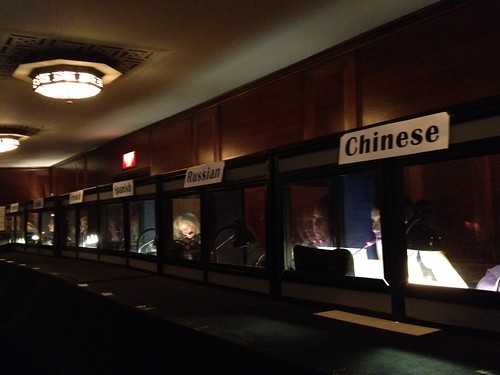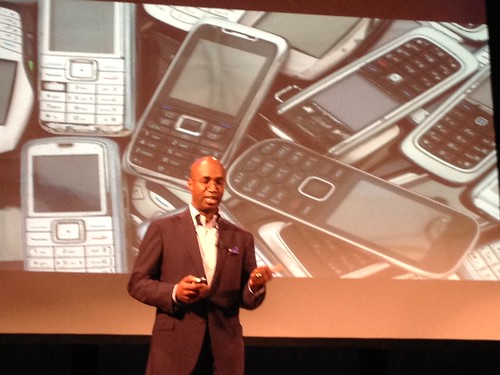
I was in NYC over the weekend and Monday to attend and speak at the Mashable Social Good Summit, a three-day conference featuring discussions and presentations with global social activists, organizations, and new media experts. Held during UN Week and Clinton Global Initiative, the speakers and agenda was diverse, interesting, and inspiring.
The event was designed for the Mashable audience, a younger and social media savvy group that has the hunger and capacity to consumer a lot of content as well as do good in the world. The agenda was packed, with 30 more plenary sessions per day (highlights here) ranging from 5 minutes solo presentations, 10-20 minute panel discussions, and live interviews via skype. But the speakers were not just technologists, they included global leaders – many who are used to a different format for conferences. As one of #sgsglobal organizers mentioned in his introduction, it was a shift for those used to giving 90 minutes!
There were a couple of big takeaways for me:
Inspiration and Feeling Good About The Desire to Do Good
Very inspired by the bloggers and @mashable @92y & @unfoundation at #SGSGlobal. Remember to watch today at 2:45pm! on.mash.to/RxjKbG
— Al Gore (@algore) September 23, 2012
The Mashable audience truly wants to do good in the world and they were inspired to hear and see many different examples and opportunities to support. And, inspiration was not a one-way street – we also heard from world leaders from the US Ambassador to the UN Susan Rice to Hilary Clinton and many others about the opportunity that young people have to do good in a connected world.
Encouraging (younger) People To Follow Their Passion About Doing Good
#scsglobal young people are capable of doing more good in the world than ever before because of online connectedness — Beth Kanter (@kanter) September 23, 2012
A theme I heard throughout the day on multiple panels was a call to action for people in the room to serve the world by following their passion. This was particularly true in Maria Bello’s story about her work in Haiti with creating a women’s network called We Advance.
What better way to see this in action is to hear it and see it from the young people themselves. The audience got a performance by J.D. Malkin, known as jdviolinboy on YouTube. In addition to being gifted musically, Malkin is also the newest youth ambassador of Save the Children, an institution that serves children in need in around the world.
But, young people are not just advocates, they can also come up with solutions and opportunities. This was the theme of a panel featuring representatives from Microsoft and Global Giving called “Bridging the Opportunity Divide.” (Here’s a reflection from Akhtar Badshah)
Thinking Big About How To Use Technology For Social Change, But Understand the Challenges
How can new media and technology create solutions in YOUR community? #SGSGlobal mashable.com/sgs twitter.com/gatesfoundatio… — Gates Foundation (@gatesfoundation) September 22, 2012
There were many examples of how social, mobile, and other new digital technologies are being used to scale good bridge digital divides.

Larry Irving talked about the many ways mobile is bridging the digital divide around the world and helping to deliver poverty reduction programs. He mentioned developments in the technology – like the $35 tablet in India – that are getting many more people who were left out connected. Irving also acknowledged that there was a lot more work to do to get nonprofits to adopt these new technologies. He asked the audience a series of questions about whether or not they thought most nonprofits they knew were using the new tools to the great impact. Not many hands went up.
I was honored to be on the agenda in the evening – in-between Mira Sorvino and Jane Goodall. I gave a 5 minute talk with a message that I always share when I speak to young people at universities in other parts of the world — to follow their passion for social change and technology, but make sure they are connect with nonprofits and their collective efforts lead to on the ground change. That it isn’t about the tools it is what you do with them.
Getting from Collective Conversation to Impact
Right now from the Social Good Global Conversation in Oman.#SGSglobal twitter.com/OmnEntrepreneu…
— Sharifa Al-Barami (@OmnEntrepreneur) September 22, 2012
The most amazing part of this summit was the global conversation that was taking place – not just in the room. There were meetups having on the ground throughout the world where people were watching the live stream and participating. In NYC, in the back of the auditorium, there was a multi-language rumble going on as translators were translating speaker’s remarks into 7 languages. I noticed that colleagues that I have met in different places in the world for my capacity building work were joining the conversation.
Conversation and engagement is the first rung on the ladder of social change. The next step is action. Many of the speakers offered specific options for people in the room to take action, hopefully followed by collective impact on the ground.
